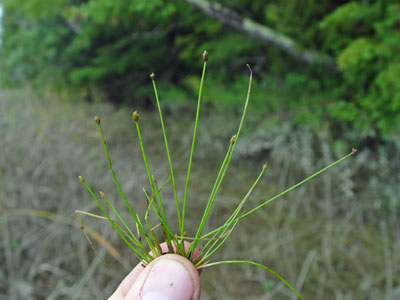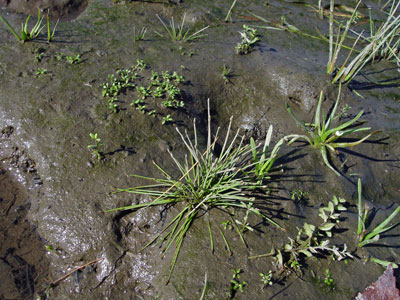DACF Home → Bureaus & Programs → Maine Natural Areas Program → Communities, Plants, and Animals → Rare Plants → Eleocharis aestuum

Eleocharis aestuum A. Haines
Tidal Spikerush
- State Rank: S2
- Global Rank: G3
- State Status: Special Concern
Habitat: Freshwater tidal river shore [Tidal wetland (non-forested wetland)].
Range: Maine south to Delaware.
Aids to Identification: Identification of this genus can be difficult without careful examination of microscopic features and a general knowledge of the group. Spikerushes are recognized by their single, terminal spike with inconspicuous basal leaves. E. aestuum can be easily confused with E. diandra and E. ovata. However, E. diandra does not occur in Maine. Distinguishing E. aestuum from E. ovata is difficult and may require expert assistance. The achene in E. aestuum is topped by a tubercle that is deltoid in shape .2-.3 x .35-.45 mm and 1/2-3/4 as high as wide. Perianth bristles are absent or 2-4, nearly 1/2 the length of the achene, slender without spinules. E. aestuum is one of the few spikerushes in Maine that grows in freshwater tidal habitats (as does E. ovata).

Ecological characteristics: Found on the Kennebec and Androscoggin Rivers in the tidal zones.
Phenology: Fruiting July October.
Family: Cyperaceae
Synonyms: Eleocharis ovata (Roth) Roemer & J.A. Schultes var. aphanactis Moore; Eleocharis palidostachys D.M. Hines, nomen nudum (never validly published).
Known Distribution in Maine: This rare plant has been documented from a total of 1 town in the following county: Sagadahoc
Reason(s) for rarity: Scarcity of habitat. Possibly confused with Eleocharis ovata and overlooked.
Conservation considerations: Degradation or alterations of hydrology of freshwater tidal marshes and shores could prove detrimental to populations.